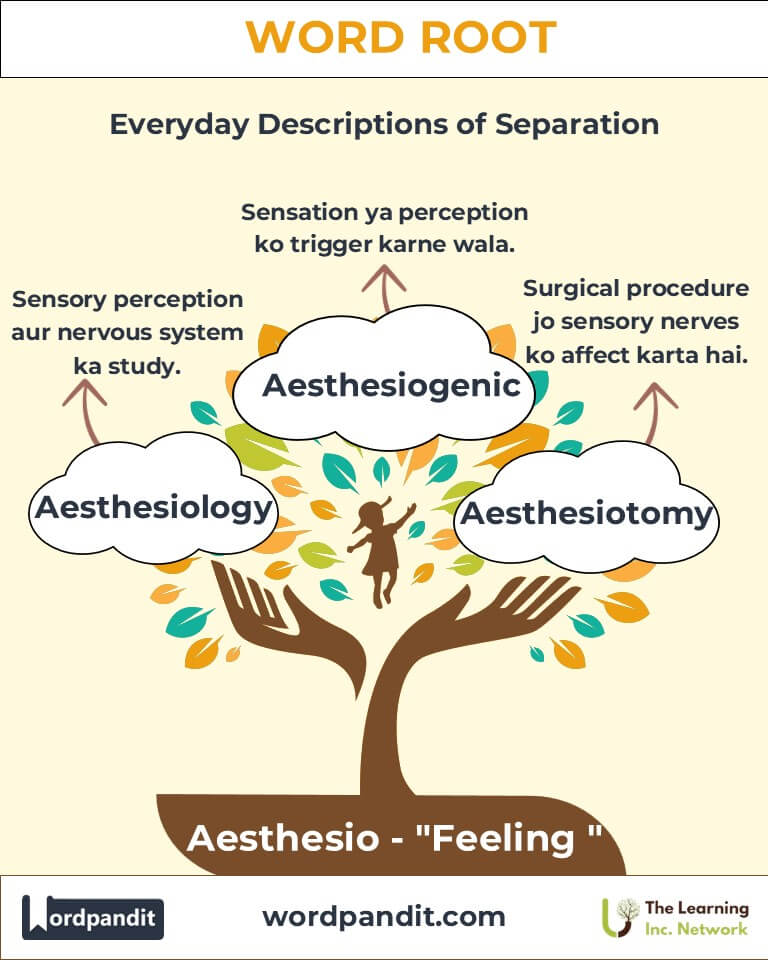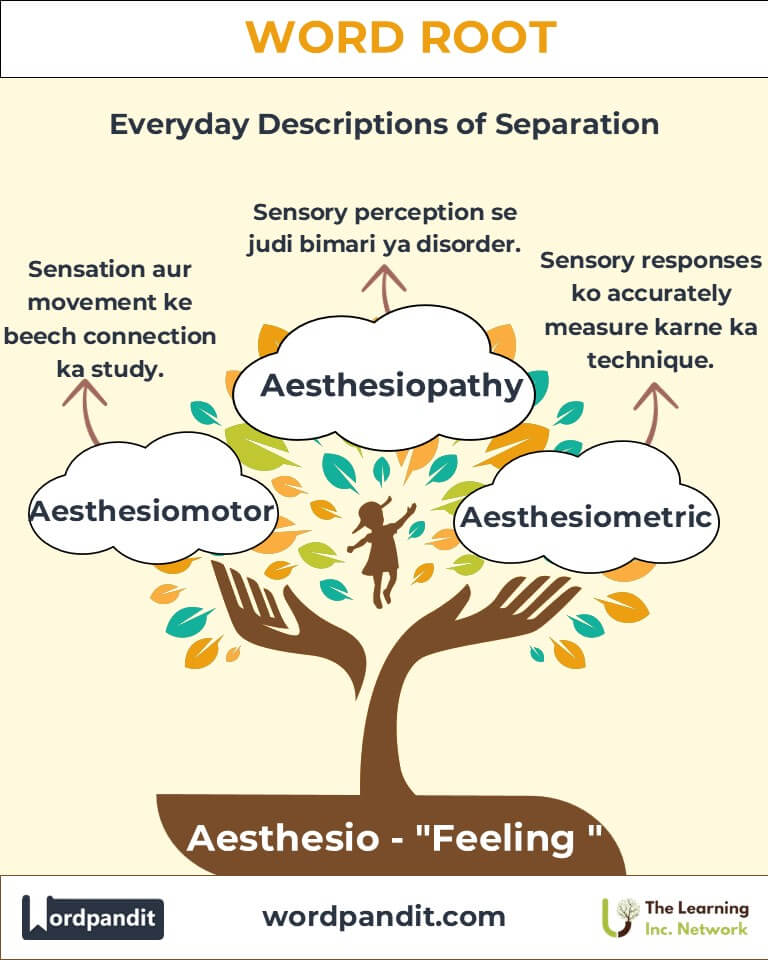Aesthesio: The Root of Sensation in Science and Language
Byline:
Delve into the fascinating world of the root "aesthesio," derived from Greek, meaning "sensation" or "perception." From medical tools like the aesthesiometer to the concept of aesthesia, this root enriches our understanding of sensory experiences across disciplines.

Table of Contents
- Introduction: The Essence of "Aesthesio"
- Etymology and Historical Journey
- Mnemonic: Unlocking the Power of "Aesthesio"
- Common "Aesthesio"-Related Terms
- "Aesthesio" Through Time
- "Aesthesio" in Specialized Fields
- Illustrative Story: "Aesthesio" in Action
- Cultural Significance of "Aesthesio"
- The "Aesthesio" Family Tree
- FAQs about the "Aesthesio" Word Root
- Test Your Knowledge: "Aesthesio" Word Root Quiz
- Conclusion: The Living Legacy of "Aesthesio"
1. Introduction: The Essence of "Aesthesio"
Pronounced es-THEE-see-oh, this Greek-derived root encapsulates the concept of sensation or perception. Whether we marvel at the sensitivity of human touch or investigate the intricacies of nerve response, "aesthesio" is central to understanding sensory processes. Its relevance spans medicine, psychology, and even philosophy, making it a cornerstone in discussions about perception.

2. Etymology and Historical Journey
The word root "aesthesio" originates from the Greek word aisthēsis (αἴσθησις), meaning "perception" or "feeling." Ancient Greek philosophers, such as Aristotle, explored aisthēsis to understand how humans perceive the world. The term evolved into scientific vocabulary through the influence of Renaissance scholars, who adopted Greek concepts to describe sensory phenomena.
3. Mnemonic: Unlocking the Power of "Aesthesio"
To remember "aesthesio," visualize a butterfly gently landing on someone’s skin—a moment of delicate sensation that captures the essence of perception.
Mnemonic Device: "A butterfly’s touch is the essence of aesthesio—soft, fleeting, and full of sensation."
4. Common "Aesthesio"-Related Terms
- Aesthesiometer (es-THEE-see-oh-meh-ter): A device used to measure sensory perception, particularly the ability to discern touch stimuli.
Example: "The neurologist used an aesthesiometer to assess the patient’s tactile sensitivity." - Aesthesia (es-THEE-see-uh): The capacity for sensation and perception.
Example: "After the surgery, the patient gradually regained full aesthesia in their legs." - Anaesthesia (an-es-THEE-see-uh): The absence of sensation, often induced medically.
Example: "The dentist administered anaesthesia before the procedure to ensure no pain." - Hyperesthesia (hy-per-es-THEE-see-uh): An increased sensitivity to stimuli.
Example: "Hyperesthesia caused discomfort at even the lightest touch on the skin." - Dysaesthesia (dis-es-THEE-see-uh): An abnormal or unpleasant sensation.
Example: "The patient described a tingling dysaesthesia in their fingertips."
5. "Aesthesio" Through Time
- Ancient Roots: In ancient Greece, aisthēsis described not only physical sensations but also emotional and intellectual perception. Philosophers debated whether sensation was purely physical or intertwined with the soul.
- Modern Application: With advancements in neurology, "aesthesio" terms became central to understanding sensory disorders, leading to the development of diagnostic tools like aesthesiometers.
6. "Aesthesio" in Specialized Fields
- Medicine: Aesthesiometer: Essential in diagnosing sensory nerve damage or recovery.
- Psychology: Hyperesthesia: Studied in cases of anxiety and post-traumatic stress disorder, where sensory sensitivity is heightened.
- Technology: Sensory Feedback Systems: Devices that replicate or measure aesthesia, particularly in prosthetics.
7. Illustrative Story: "Aesthesio" in Action
Dr. Elena Torres, a neurologist, had a patient recovering from a spinal injury. Using an aesthesiometer, she assessed his tactile sensation, ensuring that the therapy stimulated nerve regeneration. Gradually, the patient progressed from no sensation (anaesthesia) to a full return of aesthesia, celebrating each milestone with her care team.
8. Cultural Significance of "Aesthesio"
Sensation and perception have fascinated thinkers across centuries. From Aristotle’s reflections on aisthēsis to modern debates about virtual reality’s impact on sensory experiences, "aesthesio" connects humanity to the very essence of being aware.

9. The "Aesthesio" Family Tree
- Pathos (Greek: "feeling"):
- Empathy: Understanding another’s feelings.
- Pathology: The study of suffering or disease.
- Sens (Latin: "to feel"):
- Sensitive: Easily affected.
- Sensation: A physical or emotional feeling.
- Neuro (Greek: "nerve"):
- Neurology: The study of the nervous system.
- Neuroplasticity: The ability of the brain to adapt and change.

10. FAQs About " Aesthesio "
Q: What does "aesthesio" mean?
A: The root "aesthesio" means "sensation" or "perception" and comes from the Greek word aisthēsis. It relates to the ability of humans and organisms to sense stimuli, such as touch, heat, or pressure.
Q: What is an aesthesiometer used for?
A: An aesthesiometer is a tool used to measure tactile sensitivity. It helps neurologists evaluate touch perception in patients, particularly when diagnosing nerve damage or monitoring recovery.
Q: How does "aesthesia" differ from "anaesthesia"?
A: Aesthesia refers to normal sensation or the ability to perceive stimuli, while anaesthesia means the absence of sensation, often medically induced to block pain during procedures.
Q: What causes hyperesthesia?
A: Hyperesthesia, or heightened sensitivity to stimuli, can result from nerve damage, neurological disorders, or emotional stress. It’s observed in conditions like fibromyalgia or anxiety, where sensory perception is amplified.
Q: What is dysaesthesia, and how does it differ from normal sensations?
A: Dysaesthesia is an abnormal and often unpleasant sensation, such as tingling or burning, occurring without a specific stimulus. It is associated with conditions like diabetes or peripheral neuropathy.
11. Test Your Knowledge: " Aesthesio " Mastery Quiz
1. What does the root "aesthesio" mean?
2. What tool measures tactile sensitivity?
3. Which term describes increased sensitivity to stimuli?
4. What is the absence of sensation called?
5. In which field is the term "aesthesio" most commonly used?
12. Conclusion: The Living Legacy of "Aesthesio"
The root "aesthesio" bridges ancient philosophy and modern science, illuminating our understanding of sensation. From diagnostic tools to philosophical debates about perception, its legacy continues to shape how we explore the senses. As technology advances, "aesthesio" will remain vital in uncovering the mysteries of sensory experiences.












